Physical Address
304 North Cardinal St.
Dorchester Center, MA 02124
Many systemic diseases are associated with lung or pleural injury, either as a component of the disease itself or as a consequence of other types of injury induced by the disease or its treatment. This chapter focuses on systemic diseases that can involve the lung or pleura as a direct component of the disorder. Secondary lung disease can develop as an immunologic or inflammatory reaction to a wide variety of therapeutic agents or by predisposition to infections, as is the case with immunosuppressive agents used for therapy. Secondary lung disease can also arise from conditions that lead to aspiration (eg, scleroderma) and its pulmonary sequelae.
Connective tissue diseases (CTDs) are systemic rheumatologic diseases that can affect all compartments of the respiratory tract, including airways, alveoli, interstitium, vessels, and pleura. Lung disease is a common manifestation of CTDs and significantly contributes to their morbidity and mortality. CTD-related lung disease may present as diffuse lung disease or as focal lesions (eg, rheumatoid nodules), and there is significant heterogeneity between the individual CTDs in their clinical manifestations. For example, in systemic sclerosis, lung disease is a leading cause of death, whereas parenchymal lung disease is uncommon in systemic lupus erythematosus (SLE). One must also remember that the timing of the onset of lung disease in the natural history of a CTD is variable. Lung disease may presage the clinical diagnosis of the primary CTD by months to years (see section on interstitial pneumonia with autoimmune features ), or it may develop in the context of an established CTD diagnosis. In a recent study of 114 consecutive patients with interstitial lung disease (ILD) evaluated at a tertiary referral center, 15% were confirmed to have a new CTD diagnosis. Further, lung pathology may be directly related to the CTD itself, may be a complication of the effects of CTD in other organ systems (eg, aspiration pneumonia due to esophageal dysmotility in scleroderma) or related to administration of therapeutic agents (eg, methotrexate toxicity in rheumatoid arthritis [RA], or opportunistic infections after immunosuppression).
Individual CTDs tend to preferentially affect different compartments of the lung. Nearly all of the lung injury patterns described for idiopathic interstitial pneumonia are known to occur across the spectrum of CTDs, although respiratory bronchiolitis and desquamative interstitial pneumonia in these patients are likely related to smoking rather than the CTD itself. In general, a nonspecific interstitial pneumonia (NSIP) pattern of fibrosis is more common in all CTDs, except RA, where a usual interstitial pneumonia (UIP) pattern is more likely to occur. Other histopathologic features that suggest a CTD-related ILD rather than an idiopathic interstitial pneumonia (IIP) include prominence of interstitial lymphoid aggregates with germinal centers, diffuse lymphoplasmacytic infiltration, and multicompartment involvement (in addition to interstitial pneumonia) with unexplained pleural or pericardial effusion or serositis, intrinsic airway disease (airflow obstruction, bronchiolitis, bronchiectasis), or pulmonary vasculopathy.
Pleural effusion
Pleuritis, including (hypocellular) fibrinous or lymphocytic pleuritis
Pneumothorax
Empyema
UIP
NSIP
OP
Uncommonly, LIP and desquamative interstitial pneumonia
Lymphocytic and follicular bronchitis and bronchiolitis
Constrictive bronchiolitis (bronchiolitis obliterans)
Bronchiectasis and bronchiolectasis
Caplan Syndrome
Apical Fibrobullous Disease
Vascular Disease
PH
Pulmonary hemorrhage due to small-vessel vasculitis
Infections
Drug toxicity (methotrexate, infliximab, adalimumab)
Pulmonary and pleural diseases are common in patients with RA, whether as an extraarticular manifestation of the disease, an adverse effect of drug therapy, or related to comorbid conditions (eg, venous thromboembolism). Lung disease is the second most common cause of mortality in RA. Lung disease–associated mortality is related to infections, ILD, and lung cancer, whereas significant pulmonary contributors to morbidity include infection, ILD, pleural disease, and drug-related reactions. Interestingly, although RA is more prevalent in females, RA-related ILD and rheumatoid nodules are more common in males. Smoking, older age, and severity and duration of joint disease are also risk factors for ILD, as are HLA-DRB1 haplotype and presence of anticitrullinated peptide and heat shock protein antibodies. The mainstay of treatment is immunosuppression with corticosteroids and other agents.
The clinical presentation and radiographic findings depend on the nature of the pathology present in the individual patient, and coexistence of more than one manifestation is a frequent event. Pleural disease—including pleural thickening, pleuritis, and pleural effusion—is more common than pulmonary disease in RA. Pleural disease may be clinically silent or associated with chest pain. Effusions, when present, are usually small and exudative. The pleural surfaces typically show deposition of a hypocellular layer of fibrinous material that can organize over time. Multinucleated giant cells and epithelioid macrophages can be seen in pleural fluid cytology specimens. Rheumatoid nodules can also develop, primarily in visceral pleura. Rupture of a rheumatoid nodule has been postulated to account for pneumothoraces and empyemas developing in patients with rheumatoid pleural disease.
ILD is the most frequent pulmonary manifestation of RA. Interstitial changes are noted in up to 50% of lung computed tomography (CT) scans performed in patients with RA, with the most common findings being ground-glass opacities, reticulation, and traction bronchiectasis/bronchiolectasis. On pulmonary function tests (PFTs), decreased carbon monoxide–diffusing capacity is observed in up to 40% of RA patients. Bronchoalveolar lavage (BAL) fluid can demonstrate a lymphocytic or neutrophilic alveolitis. Patterns of UIP and NSIP are most characteristic, and individuals have symptomatology and radiographic abnormalities similar to patients with the idiopathic forms of these interstitial pneumonias. Histologically as well, these processes resemble idiopathic examples of UIP and NSIP. In brief, the NSIP pattern consists of a temporally homogeneous interstitial mononuclear inflammatory cell infiltrate, interstitial fibrosis, or a combination of both, without honeycombing. Cellular, fibrotic, and mixed subtypes are recognized. More detail is provided in the chapter dealing with idiopathic interstitial pneumonias (see Chapter 16 ). The UIP pattern, in contrast, consists of a temporally heterogeneous combination of interstitial fibrosis, honeycombing, fibroblast foci, and variable degrees of inflammation with a predominant subpleural distribution ( Fig. 35.1 ). The presence of lymphoid hyperplasia in UIP should raise consideration of RA or another CTD ( Fig. 35.2 ). Follicular bronchiolitis and organizing pneumonia are commonly found as minor patterns in patients with a predominant NSIP or UIP pattern. Lymphoid interstitial pneumonia (LIP) and desquamative interstitial pneumonia have been reported less frequently than NSIP and UIP in patients with RA. The prognosis of RA-associated ILD is probably related to the pattern(s) of lung disease represented. In general, patterns of UIP and fibrotic NSIP are associated with poorer survival than cellular NSIP, although CTD-related UIP patients appear to survive longer than those with idiopathic UIP/idiopathic pulmonary fibrosis. Organizing pneumonia (OP) may occur as an isolated finding, but is more commonly seen in association with other airway and interstitial abnormalities. Histologically, it consists of fibromyxoid connective tissue that fills alveoli and bronchioles, accompanied by variable degrees of chronic inflammation. It is typically responsive to corticosteroids.
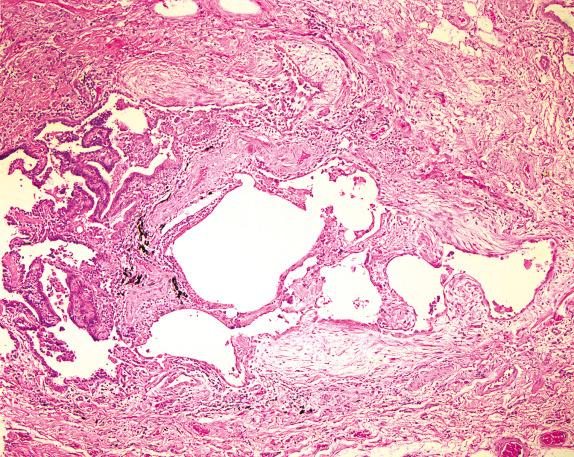
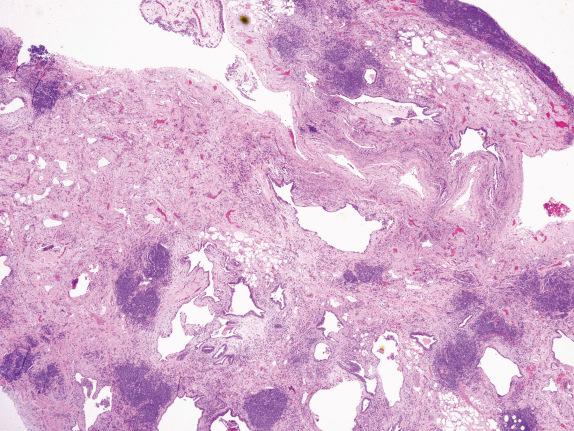
Physiologic evidence of chronic airway obstruction is found in 16% to 38% of patients with RA. Upper airway involvement includes vocal cord nodules and cord paralysis and is rare. Lower airway lesions associated with RA include chronic and follicular bronchitis and bronchiolitis, constrictive (obliterative) bronchiolitis, and bronchiectasis. Chronic airway inflammation refers to lymphoplasmacytic inflammation in the walls of airways. When accompanied by lymphoid aggregates with germinal centers, the terms follicular bronchitis and bronchiolitis are used. Follicular bronchiolitis is not uncommon and can be a cause of cough and airflow obstruction in affected patients. On high-resolution CT (HRCT) scans, follicular bronchiolitis may manifest as centrilobular nodules. Histologically, there is hyperplasia of the bronchus-associated lymphoid tissue, which forms peribronchiolar lymphoid follicles, often containing germinal centers, and can produce compression of the bronchiolar lumen ( Fig. 35.3 ).
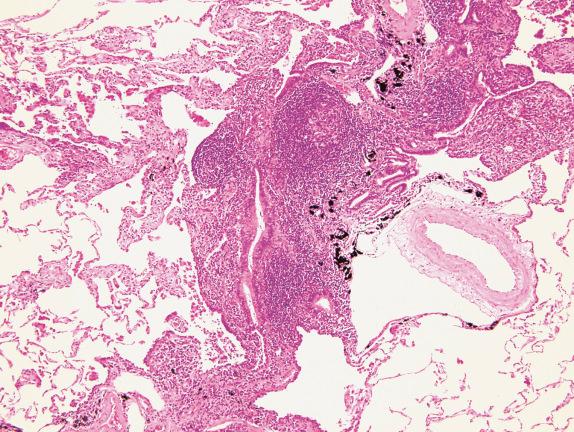
Constrictive bronchiolitis occurs more commonly in women than in men with RA and was earlier thought to be a complication of penicillamine or gold therapy. Its onset is insidious, with productive cough followed by dyspnea. Although rare, it has a high clinical and prognostic impact when present. Chest radiographs appear normal or hyperinflated, and HRCT typically shows expiratory air trapping. Histologically, subepithelial deposition of mature collagen in bronchioles is characteristic ( Fig. 35.4 ). Variable degrees and types of inflammation may accompany the collagen deposition, and there may be loss or obliteration of the bronchiolar smooth muscle layer by the fibrosing process. Luminal narrowing or complete fibrotic obstruction results. Constrictive bronchiolitis usually follows a progressive clinical course and generally has a poor response to therapy.
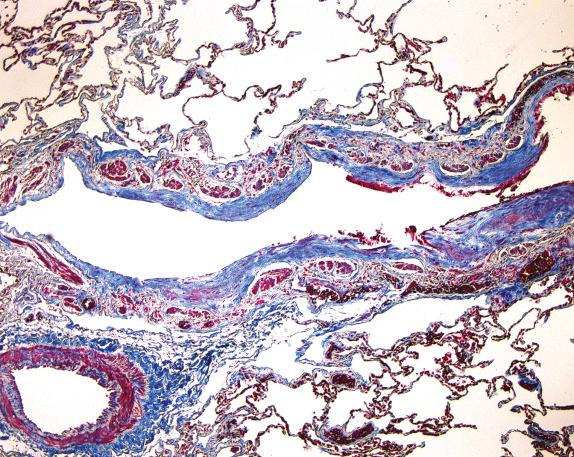
Bronchiectasis has been reported in 5% to 12% of patients with RA, according to autopsy studies, but the frequency of clinically significant bronchiectasis is much lower (1%–5%). Why patients with RA are more likely to develop bronchiectasis is unclear, but the answer may be related to an increased susceptibility to airway infections, possibly related to a defect in humoral immunity. Bronchiolectasis may be seen secondary to fibrosis (traction bronchiolectasis).
Apical fibrobullous disease, similar to that of ankylosing spondylitis, can develop in occasional patients with RA. Amyloidosis is another uncommon potential complication. Pulmonary vascular abnormalities associated with RA include pulmonary hypertension (PH) and, rarely, diffuse pulmonary hemorrhage secondary to small-vessel vasculitis.
Rheumatoid nodules can also develop in patients with RA, usually as incidental findings in the lungs or pleura. These lesions are histologically identical to subcutaneous rheumatoid nodules and consist of a focus of acellular necrosis, surrounded by a rim of palisaded epithelioid histiocytes, surrounded again by a zone of lymphocytes, plasma cells, and fibroblasts ( Fig. 35.5 ). Caplan syndrome (rheumatoid pneumoconiosis) was originally described in coal workers with RA, in whom large necrobiotic nodules resembling rheumatoid nodules developed in the lungs. Patients with exposure to inhaled silica can develop a similar picture. The nodules can measure up to 5 cm and characteristically demonstrate circumferential bands of dust within the necrobiotic zone of the nodule. The differential diagnosis includes tuberculosis and progressive massive fibrosis with ischemic necrosis.
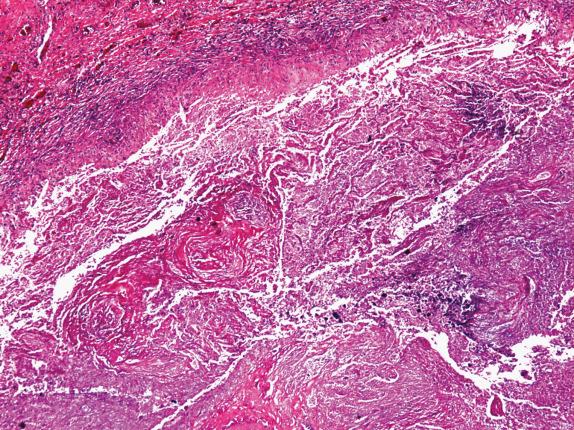
Pleuritis and pleural effusion
Chronic ILD
Chronic, follicular, and constrictive bronchiolitis
Acute lupus pneumonitis
DAH with small-vessel vasculitis
Thromboembolic disease
PH
Catastrophic antiphospholipid syndrome
Shrinking lung syndrome
Amyloidosis
Up to 50% of patients with SLE will develop SLE-associated lung disease. Abnormal respiratory physiology is a common finding in SLE, especially reduced diffusing capacity of the lungs for carbon monoxide and a restrictive pattern on PFTs. Pulmonary manifestations of SLE include pleural involvement, inflammatory and fibrotic forms of ILD, alveolar hemorrhage, shrinking lung syndrome, PH, airway disease, and thromboembolic disease. Pleural involvement (pleural effusion, pleuritis) is the most common intrathoracic presentation of SLE and may be the first indication of the disorder. Pleuritis is one of the definitional criteria for diagnosing SLE and occurs in 45% to 60% of patients. It can present with pleuritic pain, dyspnea, cough, and fever. Pericarditis can be associated. The effusion is usually a serous or serosanguinous sterile exudate with a predominance of either neutrophils or mononuclear cells. Lupus erythematosus cells can be found among the cells in the effusion. Pleural biopsy typically reveals lymphocytic and plasma cell infiltration of the pleura with fibrinous exudate and variable degrees of organization and fibrosis. In most patients, the effusion will either resolve spontaneously or will respond to corticosteroid therapy, usually within a period of days. It is important to consider other etiologies for pleural effusions in these patients, including infections, renal failure, cardiac failure, and PH, before ascribing an effusion to SLE. A pleural fluid antinuclear antibody (ANA) titer of greater than 1/160 has a sensitivity of 92% for SLE pleuritis and is helpful in this differential diagnosis.
Acute lupus pneumonitis refers to an acute pulmonary syndrome characterized by acute onset of fever, pleuritic chest pain, tachypnea, and hypoxemia. It occurs in 1% to 4% of patients and may represent the first manifestation of SLE, whereas in others it develops during the course of the disease. Imaging shows unilateral or bilateral alveolar infiltrates, particularly involving the lower lobes, and small pleural effusions. The histologic findings include diffuse alveolar damage, cellular interstitial pneumonitis, and OP. The most important differential diagnosis is that of a pulmonary infection with bacteria, viruses, or fungi, and evidence of infection should be aggressively sought. The treatment of acute lupus pneumonitis includes high doses of corticosteroids, combined in some cases with other immunosuppressive or cytotoxic agents or plasmapheresis. The process has a 50% mortality rate and a tendency to recur in survivors. There may be some overlap with SLE-associated diffuse alveolar hemorrhage (DAH).
DAH is a catastrophic complication that develops in less than 2% of patients with SLE as a consequence of immune complex deposition, neutrophilic infiltration, and destruction of pulmonary vascular endothelium. Most cases occur in women, and the median age is in the mid to late 20s. Symptoms of dyspnea, hemoptysis, and fever develop over a period of days and are accompanied by a decreasing hematocrit. Although most patients have an established diagnosis of SLE, DAH may be the presenting feature of SLE in up to one-third of patients. BAL will produce a hemorrhagic fluid sample, and lung biopsy will usually show a small-vessel vasculitis ( Fig. 35.6 ). Immune complexes can be detected by immunofluorescence or electron microscopy in some cases. The differential diagnosis includes infections with bacteria, viruses, or fungi, as well as other causes of small-vessel vasculitis. Unfortunately, a consistently successful treatment approach for SLE-associated DAH has not been determined. High-dose corticosteroid therapy by itself does not appear to be very effective, and cyclophosphamide and plasmapheresis have been added for some patients, with variable results.
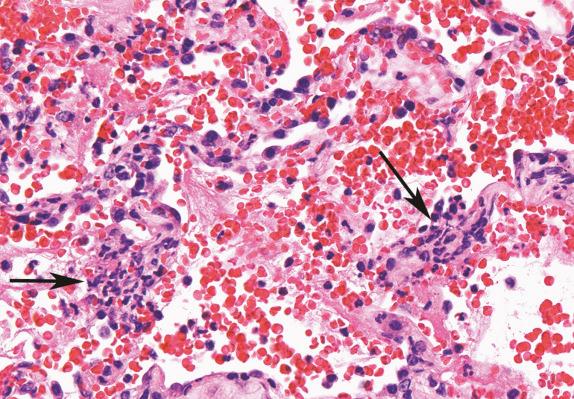
Other pulmonary vascular abnormalities found in patients with SLE include thromboembolic disease and PH. Antiphospholipid and anticardiolipin antibodies are frequently found in patients with SLE and predispose to thrombosis and embolism. Catastrophic antiphospholipid syndrome develops in rare individuals with SLE, as well as individuals possessing antiphospholipid antibodies without SLE. The syndrome presents with rapidly developing multiorgan failure due to occlusive vascular disease. The lung manifests features of the acute respiratory distress syndrome (diffuse alveolar damage), pulmonary embolism and thrombosis, and/or alveolar hemorrhage. The mortality rate is 50%, in most due to cardiac problems. Many patients are treated with a combination of anticoagulation, corticosteroids, plasmapheresis, and intravenous gammaglobulins, with recovery reported in 70% of patients in one review. PH develops in 5% to 14% of patients with SLE. Pathologic features are identical to those of other causes of PH, and rarely pulmonary venoocclusive disease can be responsible. The pathophysiology is not well understood, and antiphospholipid antibodies, antiendothelial cell antibodies, vasculitis, vasospasm, and inflammation may contribute to the development of PH. Typically, PH occurs after prolonged SLE disease duration, often after 5 years, in women under the age of 40. Acute/chronic thromboembolic disease, increased pulmonary vascular resistance, and rarely, vasculitis or pulmonary venoocclusive disease contribute. In a case-control study of 147 SLE patients, Raynaud phenomenon and the presence of anticardiolipin and anti-U1 ribonucleoprotein (RNP) antibodies were predictive of PH, with three-, four-, and fivefold increases in risk, respectively. In another study, serum rheumatoid factor positivity was significantly associated with PH, which is interesting to note because seropositivity for rheumatoid factor has been linked to hyperviscosity in RA patients.
Although CT scans reveal interstitial changes in 30% to 38% of patients with SLE, clinically significant ILD is far less common in SLE than in other CTDs, occurring in less than 15% of patients. In these patients, ILD develops insidiously and is rarely severe. The most common histologic pattern of SLE-ILD is NSIP; less common patterns include OP, follicular bronchiolitis and LIP, and UIP. Other entities such as DAH, drug toxicity, congestive heart failure, uremia, and infection also often enter into the differential diagnosis and must be excluded. Treatment with corticosteroids usually produces improvement, and methotrexate has also been used successfully.
Airway involvement can take the forms of chronic, follicular, or constrictive bronchiolitis. Amyloidosis has been reported but is extremely unusual. The “shrinking lung syndrome” is another rare complication of SLE, occurring in 0.5% to 10% of patients with the condition. In the original description in 1965, this syndrome was characterized by unexplained dyspnea, small lung volumes, and restrictive lung physiology, with or without diaphragmatic elevation, in the absence of interstitial, alveolar, or vascular pulmonary disease. Chronic pleuritis and progressive impairment in diaphragmatic movement from muscle weakness may contribute to its development. Respiratory muscles can show myopathic changes. The pathophysiology of this syndrome is poorly understood, but administration of corticosteroids may produce some improvement.
Interstitial lung disease
Nonspecific interstitial pneumonia
Usual interstitial pneumonia
Organizing pneumonia
Pulmonary hypertension
Small airway disease
Alveolar hemorrhage
Pleural fibrosis
Aspiration pneumonia
Lung involvement is found in 40% to 60% of patients with systemic sclerosis and represents the most common cause of death in patients with this condition. ILD (systemic sclerosis [SSc]-ILD) and PH are the most frequent manifestations, whereas pleural involvement, small-airway disease, and alveolar hemorrhage are rare. NSIP ( Fig. 35.7 ) is the most common histologic pattern. In the largest surgical biopsy series containing 80 patients, NSIP was present in 78%, with fibrotic NSIP accounting for more than three-quarters of the NSIP cases. Other histopathologic patterns represented in patients with SSc-ILD included UIP in 8%, “end-stage lung disease” in 8%, OP, and respiratory bronchiolitis–associated ILD due to smoking. Mortality was not linked to the histopathologic pattern of disease in this cohort but was associated with pulmonary function impairment at presentation and decline in pulmonary function during follow-up. Autoantibodies against topoisomerase I (anti-Scl-70 antibody) are strongly predictive of SSc-ILD. HRCT typically shows ground-glass opacities and reticulation; honeycombing occurs only in a minority. HRCT findings along with forced vital capacity (FVC) measurements are used in prognostication. Traditionally, BAL neutrophilia has also been used to guide treatment and prognosis. However, recent studies suggest that BAL neutrophilia reflects disease severity and may not have independent prognostic value. Treatment usually includes corticosteroids and other immunosuppressive agents, which can often stabilize or improve lung function tests and HRCT changes. Other treatments are under evaluation.
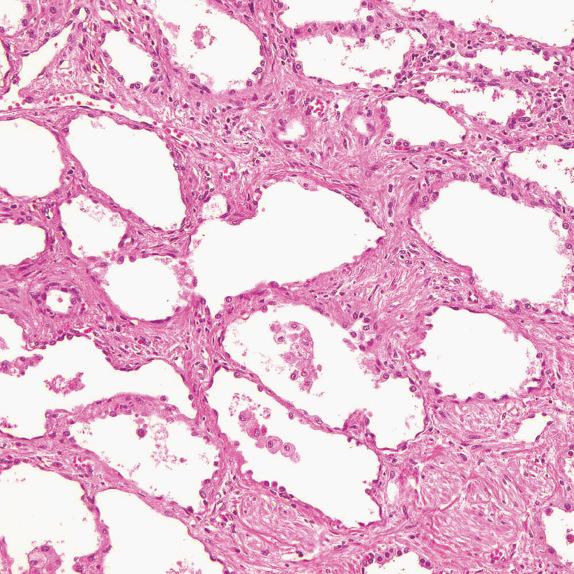
Pulmonary hypertension occurs in 5% to 33% of SSc patients, and clinically severe PH affects 9% of patients. It tends to occur late, often 7 to 9 years after diagnosis, and is associated with a high mortality rate (56% 3-year survival after diagnosis). Histologic changes are identical to primary PH.
Other pulmonary complications also arise in patients with SSc. Lung cancer incidence is increased between 4- and 16-fold in patients with SSc compared with the general population. Tumors arise primarily in patients with pulmonary fibrosis and are most frequently adenocarcinomas. Aspiration, predisposed to by esophageal dysfunction, represents another source of lung injury that may contribute to the pulmonary fibrosis in some individuals.
Airway disease
Bronchial lymphocytic infiltration, particularly in submucosal glands, and glandular atrophy
Chronic, follicular, and constrictive bronchiolitis
Bronchiectasis
ILD
NSIP
OP
UIP
LIP
Primary pulmonary lymphoma
Amyloidosis
Lung cysts
PH
Cryoglobulinemia with pulmonary hemorrhage
Pleuritis
Sjögren syndrome (SS) is a common autoimmune disease characterized by the infiltration of exocrine glands and extraglandular sites by T-lymphocytes. Diagnostic criteria include positive serology, lymphocytic sialadenitis on biopsy, and/or keratoconjunctivitis sicca. Primary SS occurs as an isolated disorder, whereas secondary SS occurs in association with a separate connective tissue disease, primarily RA. Lung involvement tends to be more common and significant in secondary SS than in primary SS. Although HRCT changes are found in 34% to 65% of SS patients, clinically significant pulmonary disease seems to affect fewer than 10% of SS patients. Risk factors for lung involvement in SS include hypergammaglobulinemia, lymphopenia, positive rheumatoid factor, presence of anti-Ro and anti-La antibodies, decreased FVC and forced expiratory volume in 1 second, history of smoking, male gender, and increased age. BAL consistently shows lymphocytosis in patients with SS, and the degree of BAL lymphocytosis may correlate with mortality and increased need for therapy.
Pulmonary involvement may be airway centered or interstitial. Airway manifestations include bronchial lymphocytic infiltration, particularly in submucosal glands, leading to atrophy; chronic, follicular, and constrictive bronchiolitis; and bronchiectasis. Patients with bronchiectasis are reportedly less likely to have an anti-Ro (Sjögren’s Syndrome A [SSA]) antibody and more likely to be antismooth muscle antibody positive. The persistent chronic inflammatory state is believed to lead to desiccation (xerobronchitis) and impairment of mucociliary clearance. Many affected patients develop a dry, irritating cough and recurrent airway infections. There is a higher frequency of respiratory infections and pneumonia in those with bronchiectasis than without. HRCT studies reflect pathology and can reveal bronchial thickening, bronchiolar nodules, bronchiectasis, and air trapping.
ILD affects 8% to 45% of patients with primary SS. Patients present with dyspnea and cough, and HRCT reveals a spectrum of abnormalities, including ground-glass, consolidation, reticular, and nodular opacities. The most common histopathologic pattern is NSIP followed by OP. Other pathologic findings can include UIP, LIP ( Fig. 35.8 ), lymphoma, amyloidosis, PH, and cryoglobulinemia with pulmonary hemorrhage. Pleural disease is not common in SS. Data on the natural history and treatment outcomes in SS-ILD are limited and variable. Immunosuppression may produce improvement or stabilization of the ILD in most patients; recently rituximab has also been proposed as standard therapy in primary SS.
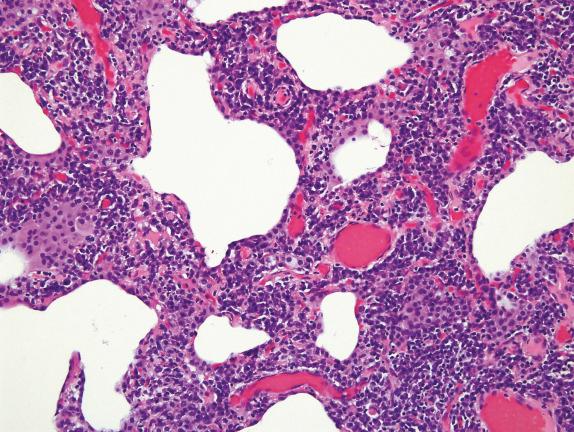
ILD
NSIP
UIP
OP
Diffuse alveolar damage
PH
Alveolar hemorrhage with small-vessel vasculitis
Lung cancer
Aspiration pneumonia
Pleuritis
Polymyositis (PM) and dermatomyositis (DM) are associated with a range of pulmonary manifestations that can arise during the course of the disease or precede other, more typical features. Pulmonary involvement in PM/DM is associated with worse outcomes and is the primary reason for hospital admission in a majority of these patients. The spectrum of pulmonary manifestations includes ILD, lung cancer (small cell and non–small cell carcinomas), aspiration pneumonia (predisposed to by respiratory muscle weakness), PH, vasculitis with pulmonary hemorrhage, and pleuritis. These complications represent common causes of death in patients with PM and DM. The presence of ILD is associated with higher rates of fever and joint involvement.
Patients with the antisynthetase syndrome have a particularly high frequency of lung disease; this syndrome includes PM or DM (63%–100%), interstitial lung disease (40%–100%), Raynaud phenomenon (25%–100%), thick cracked skin over the tips and sides of the fingers (“mechanic’s hands”), nonerosive arthritis, and the presence of one of eight antisynthetase (antiaminoacyl-tRNA synthetase [ARS]) antibodies. Of the eight known ARS antibodies, anti-Jo-1 is the most common. Collectively, anti-PL-7, anti-PL-12, anti-KS, and anti-OJ confer the greatest risk of developing ILD. Anti-MDA-5, a nonsynthetase antibody that produces a phenotype that mimics the antisynthetase syndrome and is associated with characteristic tender palmar papules and deep ulcerations, also confers a high risk for the development of ILD. Anti-MDA-5 antibodies have been associated with rapidly progressive and acute/subacute interstitial pneumonia in DM patients and represent an individual risk factor for death from ILD in these individuals.
ILD affects 20% to 30% of PM and DM patients and is associated with a poor prognosis, leading to death in 30% to 66% of patients. Both acute and chronic forms are recognized. The acute form most often has the clinical, radiographic, and pathologic features of the acute respiratory distress syndrome/diffuse alveolar damage. The prognosis is usually poor, despite treatment with corticosteroids and other immunosuppressive agents. Pulmonary hemorrhage with small-vessel vasculitis has also been reported as an acute event. More chronic presentations are associated with the histologic patterns of NSIP (usually the fibrotic or mixed type), UIP, or OP, either in pure or combined forms. In a cohort of 107 patients with DM/PM, NSIP occurred in 61%, OP in 22%, and UIP in 17% of the 41 biopsy samples available. Alveolar proteinosis has also been described. In chronic cases, HRCT scans show reticular and/or ground-glass opacities, with or without consolidation. Corticosteroids, with or without other immunosuppressants, are often used for treatment.
Patients with mixed connective tissue disease (MCTD) display overlapping features of at least two connective tissue diseases (SLE, scleroderma, Sjögren syndrome, RA, PM) and have high titers of anti-U1 RNP. Although a broad range of symptoms may be present, the most common features are Raynaud phenomenon, swollen hands with puffy fingers, arthritis/arthralgias/myalgias, esophageal dysmotility, and PH. PH is not common at presentation, but often develops with disease progression. It represents a common cause of death in patients with this disorder. Other more frequent pleuropulmonary abnormalities include ILD and pleural effusion and pleuritis. The true incidence of MCTD-related ILD is unknown; in a recent study of 126 MCTD patients, 52% had abnormal HRCT changes. Less frequently reported features include airway disease, vasculitis and alveolar hemorrhage, pulmonary thromboembolism, aspiration pneumonia, pulmonary nodules, and pulmonary cysts.
HRCT abnormalities appear to be common (range 50%–85%) in ankylosing spondylitis, even in patients with early disease. These changes include apical fibrobullous disease (most common), ILD, emphysema, bronchiectasis, and pleural thickening. Most of the published studies, however, are limited by a lack of matched control subjects.
Become a Clinical Tree membership for Full access and enjoy Unlimited articles
If you are a member. Log in here